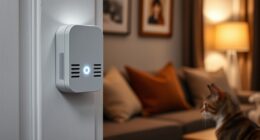To boost your home’s safety, begin by selecting a **DIY option** such as SimpliSafe or Ring. Identify any weak spots in your home, with a focus on doors and windows. Strengthen these entryways by upgrading locks and adding deadbolts. Place sensors on all accessible doors and windows to ensure complete protection. Remember to also include environmental safety sensors for smoke and carbon monoxide detection. Position the central hub in an optimal location for connectivity. Consider adding **professional monitoring services** for an extra layer of protection. Amp up your security with visible deterrents like yard signs. For more helpful advice on securing your home, keep exploring to stay safe!
Key Takeaways
- Evaluate your home's vulnerabilities, focusing on entry points like doors and windows, to determine where security measures are needed.
- Choose a security system that fits your needs, considering DIY options, wireless systems, and customizable features.
- Install entry sensors on all openable doors and windows, ensuring proper height and secure attachment for full coverage.
- Consider integrating environmental safety sensors like smoke, CO, and water detectors for comprehensive home protection.
Choose a DIY Security System
When you choose a DIY security system, you'll find options like SimpliSafe or Ring Alarm Pro that offer flexibility and easy setup without needing professional help.
These wireless home security systems are designed for quick installation, allowing you to set everything up in under two hours. You won't have to worry about extensive wiring or tools.
Additionally, much like tailored speech therapy methods, these systems can be customized to fit your specific security needs.
Look for systems that include extensive features such as motion sensors and door and window sensors, which enhance your home's security. Many of these systems also offer environmental sensors for smoke and carbon monoxide detection, ensuring a safer living space.
Smart home integration is another key aspect; this capability allows you to control and monitor your security setup remotely via smartphones or tablets.
When evaluating your options, consider the total costs. DIY systems typically range from $200 to $1,500, making them a budget-friendly choice compared to traditional professional monitoring services.
Assess Your Home's Vulnerabilities

To effectively secure your home, start by identifying its vulnerabilities, focusing on entry points like doors and ground floor windows that are often targeted by burglars.
Consider enhancing your security with reliable products such as top garage door openers that offer advanced features and smartphone connectivity.
Evaluate the size and layout of your property to pinpoint these weak spots.
Also, take a moment to analyze the crime rates in your neighborhood; if you live in an area with higher crime rates, you may need to implement more thorough security measures.
Don't forget to check for vulnerabilities in elevated areas, such as second-floor decks, which can provide overlooked access points.
Make a list of your valuable items, ensuring your security system aligns with the worth of what you need to protect.
This could include electronics, jewelry, or important documents.
Reinforce Entry Points

Reinforcing entry points is essential for deterring intruders and protecting your home from potential break-ins. Most burglaries happen during the day when homes are unoccupied, making it important to secure your doors and windows.
Start by upgrading the locks on vulnerable entry points. Installing deadbolts on your doors can greatly enhance security, as most burglars prefer to kick in doors rather than break glass. Additionally, just as proper waste management practices are crucial for environmental safety, ensuring your home is fortified against break-ins is essential for your family's safety.
Next, reinforce door jambs to create a sturdier frame that can withstand forced entry. Don't overlook your windows; consider adding security bars to make them less appealing to intruders. Conduct a thorough evaluation of all openings, including main floor windows, elevated decks, and garage access points, to identify and secure vulnerable areas.
Incorporating these measures, along with your security system installation, will help detect burglars and alert you to potential threats. By taking these steps to reinforce entry points, you're making your home a less attractive target for criminals.
Ultimately, a combination of deadbolts, security bars, and an effective home alarm system will significantly enhance your peace of mind and protect your home.
Install Sensors for Windows and Doors

Installing sensors on your windows and doors is an important step in enhancing your home security system. By using entry sensors, you're adding a vital layer of protection that can offer you peace of mind.
For a DIY home security system, position the sensors on every openable door or window to guarantee complete coverage. Additionally, guaranteeing good indoor air quality can complement your security measures, as a cleaner environment promotes overall health and well-being air purifiers remove harmful particles.
Start your sensor installation by securely attaching the sensor and magnet using double-stick adhesive tape on the jamb side of each entry point. Make sure the arrows on both the sensor and the magnet align accurately, as this optimizes functionality when the door or window opens.
To avoid vulnerability, install individual sensors on all entry points. Maintain a height of about 6 inches above the window sill, allowing for windows to remain slightly open while still armed.
Don't forget to regularly assess and test your installed sensors to verify they're functioning correctly.
Consider adding window stickers to signal the presence of your wireless security system, which can deter potential intruders. With proper installation and maintenance, these measures will greatly bolster your home security.
Add Environmental Safety Sensors

Adding environmental safety sensors, like smoke and carbon monoxide detectors, is vital for protecting your home from potential hazards.
It's important to understand personal risk factors that can influence the need for these safety measures, just as one would consider mammography guidelines for breast cancer screening.
Place smoke detectors and carbon monoxide sensors in every bedroom and hallway near sleeping areas to guarantee you're alerted early in case of danger.
Additionally, installing water sensors in areas prone to leaks, such as basements or near water heaters, can help you catch potential flooding before it becomes a costly issue.
Freeze sensors are another smart addition, monitoring temperatures to alert you if it drops below 41°F, preventing frozen pipes and property damage.
Many modern alarm systems integrate these environmental safety sensors, providing real-time notifications via text or email when you're away from home.
To keep your safety sensors functioning properly, regular testing and maintenance are vital.
Verify you check the batteries and functionality of your smoke detectors and carbon monoxide alarms at least once a month.
With a robust monitoring service in place, you can have peace of mind knowing that your home is protected from environmental threats, allowing you to focus on what really matters.
Implement Video Surveillance

To enhance your home security further, implementing video surveillance can provide real-time monitoring and deter potential intruders before they even approach your property.
With the advent of smart devices, you can easily integrate wireless cameras that allow for monitoring from anywhere. These systems often include motion detection features, ensuring that recording only occurs when there's actual movement, optimizing storage use.
Additionally, a methodical approach to monitoring your property can help identify patterns of behavior and enhance your overall security strategy, similar to how effective communication skills facilitate collaboration in quality assurance teams.
Consider these key benefits of adding video surveillance to your home security system:
- Real-time alerts: Get notifications on your smart devices when motion is detected, so you can respond promptly.
- Recorded footage: Invaluable for police investigations, recorded footage serves as vital evidence if a break-in occurs.
Optimize System Connectivity

Enhancing system connectivity is essential for ensuring that your home security system operates smoothly and effectively.
Start by placing the hub of your wireless security system in a central location within your home. This maximizes signal strength and connectivity with all sensors and cameras, reducing the chances of dropped signals. Additionally, similar to how solar panel efficiency varies based on placement and type, the positioning of your security hub can greatly affect its performance.
Connect the hub to your router using an Ethernet cable or Wi-Fi, enabling smartphone integration for remote monitoring and control. Regularly check for firmware updates on your security devices to maintain peak performance and protect against vulnerabilities.
To improve connectivity, consider setting up a dedicated network for your security devices. This minimizes interference from other household devices, ensuring your system operates seamlessly.
Additionally, pay attention to the power requirements of your setup. Confirm that the hub and all components have a reliable power source and consider using battery backups for uninterrupted operation during power outages.
Ensure Proper Installation Techniques

Proper installation techniques are essential for maximizing the effectiveness of your home security system. To guarantee proper installation techniques, start by placing the base station in a central location, connected to continuous power. This way, it can reliably communicate with all your wireless systems and sensors.
Install a security sensor on every vulnerable entry point, like main floor windows and doors. Use double-stick adhesive tape for secure attachment, aligning the arrows on the sensor and magnet for peak functionality.
Make sure to:
- Test all components after installation to confirm they're operational.
- Schedule regular maintenance checks, including battery replacements and software updates.
Regularly testing your system and performing maintenance checks will ensure ongoing reliability. By following these steps, you'll not only enhance your home's security but also enjoy peace of mind knowing you've taken the necessary precautions.
Consider Monitoring Services

After ensuring your home security system is installed correctly, it's important to think about monitoring services that can enhance your protection further.
Professional monitoring offers 24/7 oversight, ensuring immediate notifications for emergencies like break-ins, fires, or carbon monoxide leaks. This level of vigilance can be essential for your peace of mind.
If you opt for a monitored alarm system, it's worth noting that many insurance companies provide discounts on your home insurance premiums, potentially saving you 5-20%. Subscription fees for these professional monitoring services typically range from $10 to $50 per month, depending on the features you choose.
For those who enjoy a hands-on approach, hybrid monitoring systems allow you to self-monitor through mobile apps while also providing professional oversight. Just remember that some cities require a permit for home security monitoring services, usually costing around $25 per year.
Whether you choose a DIY alarm or a fully monitored system, considering these options will greatly enhance your home's security.
Enhance Security With Deterrents
To effectively enhance your home's security, contemplate using visible deterrents like yard signs and window stickers that signal the presence of a security system. These simple additions can greatly reduce the likelihood of a break-in. In fact, homes with these indicators are 300% less likely to be targeted by burglars. By creating the impression of an active alarm system, you'll make your property less appealing to intruders.
Here are a few effective deterrents to contemplate:
- Yard signs: Place them prominently in your yard to announce your security presence.
- Window stickers: Display these on windows to reinforce your home's protection.
Additionally, integrating video doorbells and a professional alarm system further enhances your security. Remember, burglars are looking for easy targets.
Frequently Asked Questions
How Much Does It Cost to Add a Home Security System?
When considering a home security system, you'll typically spend between $200 and $2,000. Factor in installation costs, equipment prices, and monthly monitoring fees, which can greatly affect your overall investment and long-term expenses.
Can I Install a Home Security System Myself?
Sure, you can totally install a home security system yourself! With wireless components and basic tools, it's like building a Lego set—just follow the instructions, and you'll have peace of mind in no time!
Do You Need an Electrician to Install a Security System?
You don't need an electrician for a wireless security system since you can easily install it yourself. However, if you choose a wired system, hiring a professional might be necessary for proper setup and safety.
How Can I Add More Security to My House?
To add more security to your house, upgrade locks, reinforce doors, and install sensors on windows. Don't forget motion detectors and visible deterrents like signs to signal that your home's protected against intruders.
Can I Use DIY Methods to Add a Home Security System?
Yes, you can use diy home security system steps to add a home security system. Many affordable options are available, such as installing motion sensor lights, securing windows and doors with smart locks or sensors, and setting up security cameras. Following these DIY steps can help protect your home.
Conclusion
By taking these steps, you're not just adding a security system; you're wrapping your home in a warm blanket of safety.
Armed with knowledge, you can turn your castle into a fortress, keeping unwanted guests at bay.
Whether it's a DIY setup or professional monitoring, each choice strengthens your peace of mind.
So go ahead, take the leap—because a secure home isn't just a luxury; it's a comforting embrace in a world full of uncertainties.









